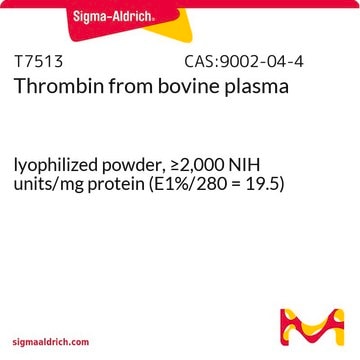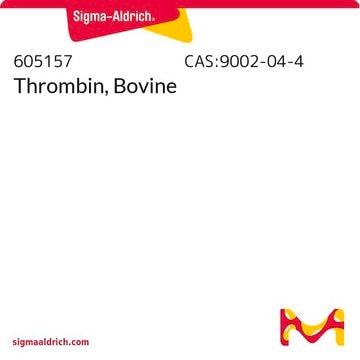T7201
Thrombin from bovine plasma
lyophilized powder, ≥2,000 NIH units/mg protein (E1%/280 = 19.5)
Synonym(s):
Factor IIa
Sign Into View Organizational & Contract Pricing
All Photos(1)
About This Item
CAS Number:
MDL number:
UNSPSC Code:
12352204
NACRES:
NA.54
Recommended Products
form
lyophilized powder
specific activity
≥2,000 NIH units/mg protein (E1%/280 = 19.5)
mol wt
heavy chain ~31 kDa
light chain ~6 kDa
storage temp.
−20°C
Looking for similar products? Visit Product Comparison Guide
General description
Thrombin is the final coagulation protease in regard to hemostasis, promoting both procoagulant and anticoagulant effects. Thrombin consists of A-chain and a catalytic B-chain with the catalytic pocket comprising of His57, Asp102, Ser195 and Ser214. It has a fibrinogen recognition site (FRS) and a heparin binding site (HBS) in the C-terminus. The main function of thrombin is cleavage of fibrinogen to fibrin. It coordinates the coagulation cascade and binds to diverse substrates. It coordinates with protease-activated receptors (PARs) to accomplish the physiological functions. High levels of thrombin elicit neurotoxicity in dopaminergic neurons and contribute to the progression of Parkinson′s disease. Altered thrombin levels modulates coagulation pathway in multiple sclerosis. Patients with coronary artery disease (CAD) show elevated levels of thrombin.
Application
Thrombin from bovine plasma has been used in the cleavage of the maltose binding protein tag in mini-calpain-5 fusion protein and in thrombin/hirudin spiking experiments in serum samples.
Thrombin is used for site specific cleavage of recombinant fusion proteins containing an accessible thrombin recognition site for removal of affinity tags. Thrombin has been used in a study to assess a novel antiplatelet therapy in acute coronary syndromes.
Biochem/physiol Actions
Serine protease that selectively cleaves Arg-Gly bonds in fibrinogen to form fibrin and fibrinopeptides A and B.
Unit Definition
Activity is expressed in NIH units obtained by direct comparison to a NIH thrombin reference standard.
Physical form
Lyophilized from saline sodium citrate buffer, pH 6.5
Preparation Note
Traditional thrombin products are activated with bovine brain, whereas T7201 is activated with bovine lung and does not contain any bovine brain products.
Analysis Note
Activity is expressed in NIH units obtained by direct comparison to a NIH Thrombin Reference Standard, Lot K.
The NIH assay procedure uses 0.2 mL of diluted plasma (1:1 with saline) as a substrate and 0.1 mL of thrombin sample (stabilized in a 1% buffered albumin solution) based on a modification of the method of Biggs. Only clotting times in the range of 15-25 seconds are used for determining thrombin concentrations.
Other Notes
View more information on thrombin at www.sigma-aldrich.com/enzymeexplorer.
Storage Class Code
11 - Combustible Solids
WGK
WGK 2
Flash Point(F)
Not applicable
Flash Point(C)
Not applicable
Personal Protective Equipment
dust mask type N95 (US), Eyeshields, Gloves
Certificates of Analysis (COA)
Search for Certificates of Analysis (COA) by entering the products Lot/Batch Number. Lot and Batch Numbers can be found on a product’s label following the words ‘Lot’ or ‘Batch’.
Already Own This Product?
Find documentation for the products that you have recently purchased in the Document Library.
Customers Also Viewed
Small-angle X-ray scattering of calpain-5 reveals a highly open conformation among calpains
Gakhar L, et al.
Journal of Structural Biology, 196(3), 309-318 (2016)
Thrombin-mediated degradation of parathyroid hormone in serum tubes
Laulu SL, et al.
Clinica Chimica Acta; International Journal of Clinical Chemistry, 437, 191-196 (2014)
Karin A L Müller et al.
Current vascular pharmacology, 10(5), 606-618 (2012-06-26)
Acute coronary syndromes (ACS) are triggered by enhanced platelet activation and aggregation. Hence, a cornerstone of successful secondary prevention in ACS is an effective platelet inhibition. Additionally, coronary interventions (PCI) lead to even increased artherothrombotic risks, another challenge in preventing
Directing thrombin
Lane DA, et al.
Blood, 106(8), 2605-2612 (2005)
Thrombin domains: structure, function and interaction with platelet receptors
De Cristofaro and De Candia E
Journal of thrombosis and thrombolysis, 15(3), 151-163 (2003)
Our team of scientists has experience in all areas of research including Life Science, Material Science, Chemical Synthesis, Chromatography, Analytical and many others.
Contact Technical Service










